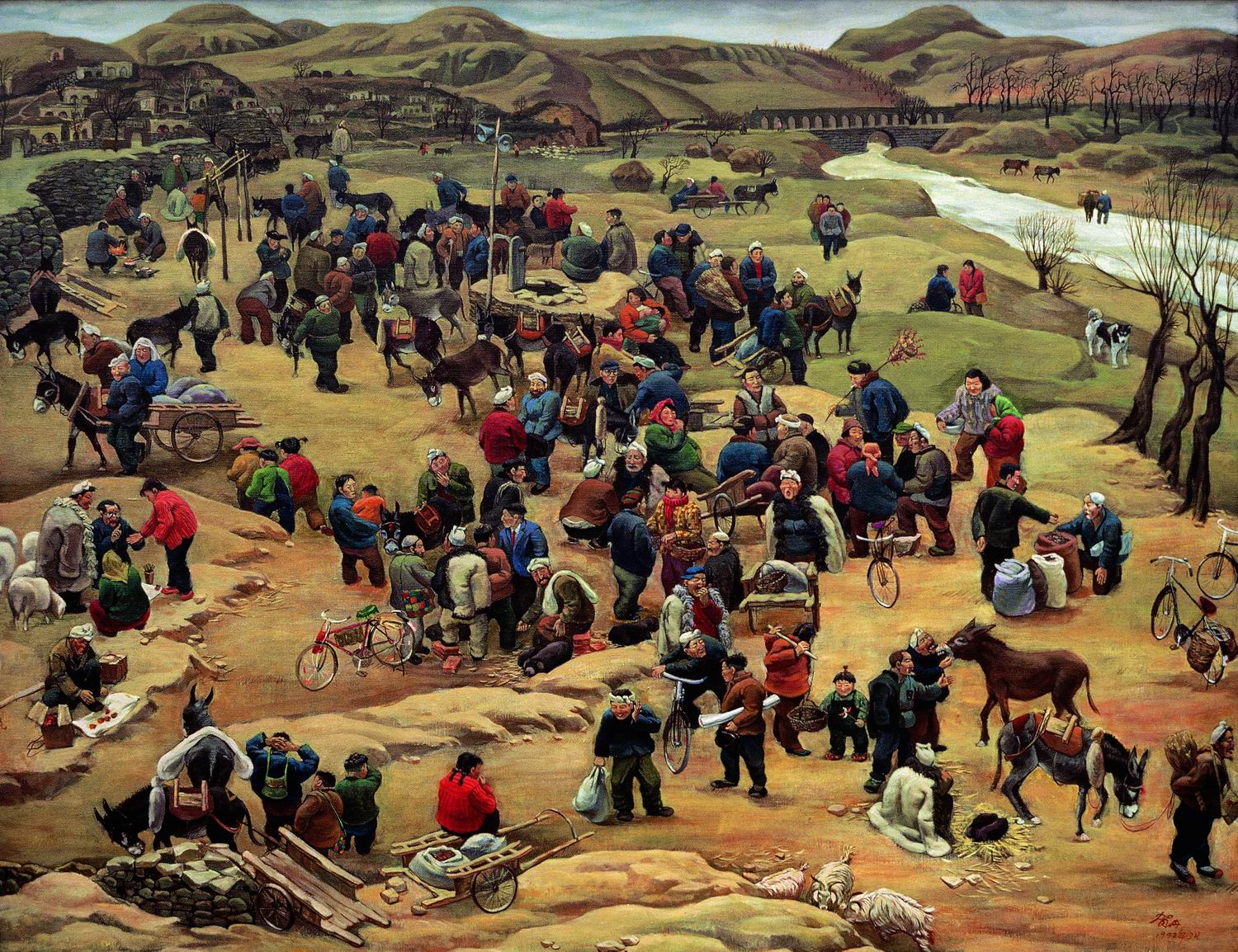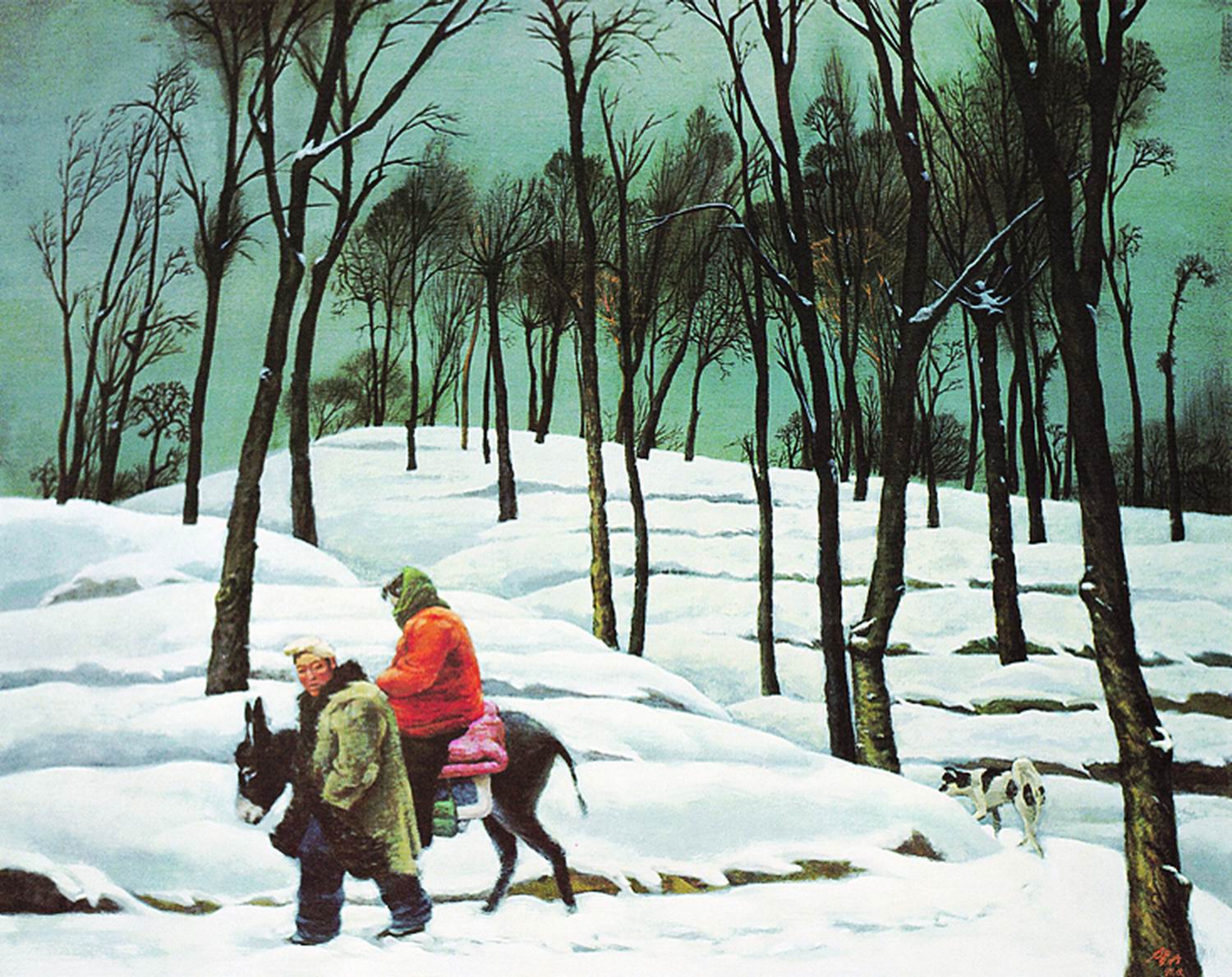评论观点
Comment
技术运用和观念表述——关于贺丹油画创作
发布时间:2021-03-05

文:王林
贺丹作品的主要兴趣在画众多的人,这是些出现在某种场景中的众生像。对贺丹而言,画画的最佳视角是杨峰先生点出的“四十五度俯视”。这个点抓得非常准。为什么?因为对透视要求而言,四十五度俯视,可以说是画画时最不严格、最有自主性的角度。这个绘画视角正是二维度平面媒介和三度空间表达的中介,对于人物远近关系的处理、对于形象塑造从清晰准确到模煳概括的把握,显然有更多自由发挥的余地。
艺术创作总是戴着镣铐跳舞。在此前提之下,我们来讨论贺丹油画的技术运用和观念表达,是一种案例分析,旨在阐释油画作为架上艺术,对当代艺术创作还有何种意义。
贺丹从习画开始,就受到过学院绘画的长期训练,主要是苏派系统,即契斯恰柯夫美术教育对绘画的要求:“把物体描绘成它在自然中存在的那样和像我们眼睛所看见的那样。”有一点不同的是,贺丹很早就师从靳之林先生。靳先生除了让贺丹以素描临摹法国画家德拉克洛瓦的黑白照片之外,还有一个因素,就是靳之林以画家出身研究民间艺术,对贺丹有相当大的影响。后来贺丹还在陕西组织过中法民间艺术家的国际交流活动,推动过西安美院收藏印度的民间艺术品。他对农民画情有独钟,对中国民间绘画的散点透视十分熟悉。后来留学法国,贺丹首先感兴趣的就是勃吕盖尔具有风俗特色的农民画,其人物造型敦实粗矮,有变形亦有夸张,和法国学院派绘画传统很不相同。此时贺丹作品,亦取众多人物构图,以固有色平涂为主,用人物轮廓线远近清晰的画法,不注重整体明暗关系的处理,由此形成其农民题材绘画创作的基本特点。
作为一个自治性很强的人,贺丹不愿顺着一种样式的风格化永远走下去,本来他可以在这条路上成为一个卖得很好的画家。为了改变自己的创作状态,贺丹不断汲取其他艺术资源,去卢浮宫临摹学院派油画,认真研究哥雅、巴尔丢斯、弗洛伊德等人作品,对莱比锡画派的尼尔·劳赫亦深感兴趣。可见他的艺术追求,乃是运用多种不同画法,以期在具象绘画中对固有风格样式力求突破,用个人化、综合性的艺术表达,来争取自我发挥的创作自由。
具象绘画自有其写实要求,贺丹油画技术的多元性和多样性,是其写实性具象绘画的基础。而简化古典油画繁复而缓慢的绘制工艺,则是改变学院派集体系统的有效策略。由此,绘制方法的个人化和创作思路的观念性,不谋而合。从形态学角度看,当代艺术大致可以分为观念艺术和架上艺术两大类,而架上艺术的观念化和观念艺术的感觉性,自有其相互推动的作用。这对于社会生活中集体主义意识仍然占据主导地位的中国艺术家而言,如何通过艺术创作中的问题意识和批判精神,去激发艺术家显现与潜在的个人创造力,至关重要。从某种意义上讲,改革开放以来,中国文化的历史进步,就是从当年“自我表现”之争到艺术界对个人创造力的普遍认可,已成为从江湖到市场,从学院到官方的基本共识
贺丹来自西安美院,这里比较一下分别来自川美和央美的两位画家,以分析分析贺丹油画的创作特点。
比如庞茂琨,尽管言说图像时很少提及绘制功夫,但其技术基础乃是素描造型的准确性,加上古典油画晕染技法的程序简化与快速完成,呈现出图像时代的当下观看。画家通过种种图式的自我观看与观看自我,揭示出国人自我消费、自我消耗乃至自我消解的文化图景。
又比如刘小东,直接写生能力的确为人所不及。其作把追求写生感作为绘画创作的主要方法加以凸现,以此沟通作品的在场性、在地性与身体性,因而具有社会—历史现场的针对性与见证意义。
相对于两位属同美院身份的画家,贺丹作品最突出的地方,乃是其画法的速写感。绘形写图,不求琐细,往往是寥寥几笔,一个头像快速绘就。而画面人数之众,少则数十,多则上千,必须精心布局,各得其所。其“速写”之谓,一是以“默写”为主,二是以“特写”为重。
贺丹默记人物形象的能力非凡,作品人数众多,但大多皆依靠记忆。他经常把自己和周边熟人画进作品,即使偶用照片,也是在新闻图片中选择。其实速写也好,默写也好,特写也好,都是一个“写”字。写之于绘,就是注重书写的生动、自由,在快速绘制中达到流畅自如,不拘一格。贺丹笔下的人物形象或五官完整,表情丰富;或眉目不清,动态各一,其衣纹服饰并不依照整体统一的亮暗关系。什么地方需要阴影就加上阴影,什么地方多了个人或少了个人,就加上或去掉。甚至有意识留出未完整效果或局部破坏性效果,以增加随心所欲的活泼。在一定程度上打破定点透视之后,绘画得以从规定的纵深中解放出来,让直接画法的绘画性更有观念表达的可能,也就有了更多利用平涂图像的机会。一一这或许是贺丹追求当代绘画视觉效果的要义之一。
贺丹画人,形貌灵活多变,姿态动作各异,这是记忆默写的长处。他只有在画手的时候最为写实,在力图营造整体氛围的同时,为突出人物的兴奋感,手的出现总是因紧张而痉挛。群体的情绪往往是不由自主的,并在狂热中互相传递,加速发酵,不断酝酿。贺丹对这种“沉默大多数”集体态势的判断,是很准确的。当然,其画画的投入,很大程度上取决于艺术家的临场发挥。归根到底,他还是一位具有中国文化情结和法国浪漫传统并富有感性气质的画家。
贺丹画作中的群体一一农民或其他人群,或者集结,或者围观、或者溃散,或者奔逃、或者行进、或者漂移,总有一种不由自主的力量在驱使着他们。一方面对中国人的铺天盖地的集体主义深感惊悚,这可以说是贺丹对传统社会、族群记忆和文化惯性的反省。但另一方面,他又不能不以一种宿命心态,来消解自己和所有人。他对近处远处的俯视,包括他对自我形象的俯视,就像一个孩童倦伏在地,兴致勃勃,全神贯注地观察蚁行的队伍。他的幽默是对人情物理的洞察,也是悲天悯人的心境。对于这样一种生存状态,我们每个人都是其中一员,并不能置身于历史问题和现实问题之外。这些作品越是没有具体的现场真实,就越是具有文化的整体象征性。荒诞感是双重性的:裹胁与激情、白日梦与碎片化、不容选择的共同命运与个体所作的毫无意义、难能可贵的绘画选择与被动被廹的真实境遇,构成了贺丹艺术创作的基本矛盾。他不可能在有生之年克服这种矛盾,只能通过有限的选择,来证明自己的存在价值。历史总是在宿命的哀叹中前进的,贺丹如此,国人如此,中国文化之命运又何尝不是如此呢?
贺丹之作是对中国群像的历史特写。
他曾用蜂群、蚁群等等刻画,来转换现实针对性,但这种更倾向形式性、装饰感和平面化的图像,对贺丹而言,似乎不足以揭示一个时代的秘密。贺丹还是回到了对人的表达,近作更是返回到一种莫名其妙的场景:诡秘、怪异,非均衡,不协调。环境光照不期而遇,人物视向互不关涉,三五成群,相聚无由,特别出人意外。没有共同的目标,没有沟通的意图,也没有相互之间的依托。这里只有危机在场,突如其来,充满惊恐与不安。作品从宏大叙事的社会象征转向微观叙事的心理暗示,既是隐喻也是影射。我以为,此一创作思路乃是贺丹对国人现实境遇和文化心理的深度揭示,值得进一步延伸与拓展。
中国传统文化的现代化改变,是一个极其复杂、极其艰难的过程,只要有助于个人性及其创造力的生长,艺术自会对中国的文明进步产生推动作用。贺丹对此有自觉的问题意识,也有直面问题的开放态度。他对油画艺术的追求是终身制的,其最佳状态正是立足于学院身份,去沟通绘写与图示,让个人创作的灵性生长在普通与杰出之间。这也许是贺丹作为一个学者型画家实现创作理想、践行实验精神的人生追求。
值此贺丹赴京展览之际,写了上述的话,作为感想,请教于美院的朋友们。
2019年6月23日
于四川美院桃花山

Technical application and concept representation
——About He Dan’s Oil Painting Creation
Wang Lin
The main interest of He Dan's works is to draw a large number of crowd and these are the images of beings appearing in certain scenes. For He Dan, the best perspective for painting is the “forty-five-degree overlook” that pointed out by Mr. Yang Feng. In my opinion that point is very accurate. But why? Because of the perspective requirements, the forty-five degree angle can be said to be the least stringent and most autonomous in oil painting. This perspective of oil painting is the intermediary of two-dimensional planar media and three-dimensional spatial expression. It is clear that there is more space for freedom to deal with the relationship between the characters' distance and how to create the image from clear and accurate to fuzzy generalization.
In fact, artistic creation always dances like wearing a shackles. Under this premise, let us to discuss the technical application and expression of He Dan’s oil painting. It is a case study to explain what the significance of oil painting as an easel art could dedicate to contemporary art.
From the beginning of his paintings, He Dan received long-term training in college painting and mainly the systematic education of art with the model of the former Soviet Union. Namely the requirements of Cheschakov's art education system for painting: "The object is depicted as it exists in nature and as we see it in our eyes." But his teacher Jin Zhilin showed him different path to develop his art career since the early days. In addition to letting He Dan sketch the black and white photos of the French painter Delacroix and there is another factor. Jin Zhilin is an artist who’ve studied folk art for many years and given a considerable influence on He Dan. Afterwards, He Dan also organized an international art exchange event between Chinese and French folk artists in Shaanxi, and promoted the collection of Indian folk art by Xi'an Academy of Fine Arts. He has a special interesting in peasant painting and is very familiar with the scattered perspective of Chinese folk painting. Subsequently he went to France and started to study west art. He Dan was very interested in the peasant paintings of Bruegel's custom features during this period. The characters in his painting were chubby, stocky. They were distortions and exaggerations and very different from the French academic painting tradition. At this time, He Dan's works also take a lot of characters' composition, focusing on the inherent color, using the outline of the characters to draw a clear and clear picture, and not paying a lot attention to the overall relationship between the light and dark, thus forming the basic characteristics of his peasant paintings.
As a self-disciplined person, He Dan does not want to use highly stylized manner to paint. In fact, he could be a very good painter on this road. In order to improve his creative level, He Dan continued to absorb other art resources. He went to the Louvre museum to learn oil paintings and paid seriously attention the works of Goya, Baldis, and Lucian Freud He is also deeply interested in Neo Rauch’s painting of the Leipzig School. It can be seen that his artistic pursuit is to use a variety of different painting methods in order to strive for breakthroughs in the intrinsic style in figurative painting, and using personal artistic comprehensive to expression to obtain self-development freedom.
The figurative painting has realistic requirements. The diversity and diversity of He Dan's oil painting technique is the basis of its realistic figurative painting. Simplifying the complicated and slow drawing process of classical oil painting is an effective strategy to change the academic education system. Thus, the personalization of the drawing method and the conceptuality of the creative ideas are inconsistently integrated. From the perspective of morphology, contemporary art can be roughly divided into two categories: conceptual art and easel painting. The conceptualization of art on the shelf and the sensoryness of conceptual art have their own mutual promotion. For Chinese artists who still dominate the collectivist consciousness in social life, it is very important to acquire how to stimulate the artist's appearance and potential individual creativity through the consciousness of question and critical thinking in artistic creation is very important. In a certain sense, since the reform and opening up, the historical progress of Chinese culture development has been from the "self-expression" dispute of the year to the universal recognition of individual creativity in the art world. It has become the common perception among the people and society.
He Dan had graduated from Xi'an Academy of Fine Arts. Hereby I’d like to compare two painters in each case from fine art academy of Si’chuan and Central Academy Of Fine Arts of China to compare the characteristics of composition with He Dan’s oil painting.
For example, Pang Maokun, although the picture is rarely mentioned in drawing effort, but its technical basis is the accuracy of sketch modeling, coupled with the simplification and rapid completion of the classical oil painting smudge technique. The presence of current observation of the picture era. Through various self-observation and self-interpretation, the painter reveals the cultural picture of self-consumption, self-deconstruction and even self-digestion.
Another example is Liu Xiaodong, whose ability to do quickly sketching and is really better than the others. Its work highlights the pursuit of sketching as the main method of painting producing in order to communicate the presentity, locality and embodiment of the works and thus having the relevance and witness significance of the social-historical scene.
Compared with the two painters who belong to the identity of the Academy of Fine Arts, the most prominent part of He Dan's works is the sketch of his paintings. Drawing and writing, not trivial, often an avatar quickly painted with a few strokes. The number of crowd in the picture ranges from a few dozen to more than a thousand. It must be carefully laid out and each has its place. Its "sketch" means that "one is based on dictation" and the other is on "close-up".
He Dan’s ability to remember characters of his painting is extraordinary. The large number of works he did that most of them rely on memory. He often draws himself and his surrounding acquaintances into his works, even if he uses photos. He chooses them in the news photos. In fact, sketching, dictation, close-up are all a "sketching". Sketching in painting is to pay attention to the vivid and achieve smooth freely in the rapid drawing, eclectic. He Dan's characters or facial features are complete, and his expressions are rich; or their eyebrows are unclear and dynamic, and their clothing are not in accordance with the overall unity of light and dark. Where to add shadows and where need more individuals or less individuals. Even consciously leave incomplete effects or partial destructive effects to increase the liveliness of whatever you want. After breaking the fixed-point perspective to a certain extent, the painting can be liberated from the prescribed depth, and the painting style of the direct drawing is more likely to be expressed by the concept, and there is more opportunity to use the flat-painted image. This may be one of He Dan’s pursuit of the visual effects of contemporary painting.
The figures in He Dan’s painting, the shape is flexible and changeable and the gestures are different. This is the strength of memory dictation. He is only the most realistic when painting the hands. While trying to create an overall atmosphere, in order to highlight the excitement of the characters, the appearance of the hand is always embarrassed by tension. The emotions of the group are often involuntarily and they pass each other in the enthusiasm, accelerate the fermentation, and continue to brew. He Dan’s judgment on this “silent majority” collective situation is very accurate. Of course, the input of his paintings depends to a large extent on the artist's presence. After all, he is also a painter with a Chinese cultural complex and a French romantic tradition and a sensual temperament.
He Dan's work is a historical close-up of the Chinese group image.
He used characterizations of swarm, ant colonies, etc. to transform realistic pertinence, but this more formal, decorative, and flattened image does not seem to reveal the secrets of an era for He Dan. He Dan still returned to the expression of people, and the recent work returned to an inexplicable scene, secret, weird, unbalanced, uncoordinated. The ambient lighting meet unexpectedly and the characters do not concern about each other. And they are in a group of three or five. There is no common goal, no intention of communication, and no mutual support. Only the crisis is here and suddenly falls into full of panic and uneasiness. The shift from the social symbol of grand narrative to the self-suggestion of micro narrative is both the metaphor and reflection. I believe that this creative idea is He Dan's deep revealing of the real situation and culture mental state of the Chinese people, which deserves further extension and expansion.
The modernization of Chinese traditional culture is an extremely complicated and difficult process. As long as it contributes to the growth of individuality and Creativeness, art will promote the progress of civilization development in China. He Dan has a conscious awareness of the problem and an open attitude to think the problem. His pursuit of oil painting art is lifelong. The best state is based on the identity of the college to communicate and keep drawing so that the spirituality of individual grows between ordinary and outstanding. This may be the life pursuit of He Dan as a scholar-type artist to achieve his creative ideals and practice the spirit of experiment.
On the occasion of He Dan’s visit to Beijing, I wrote the above words. As a feeling, I’m very looking forward the feedback from other researchers and artists at the Academy of Fine Arts.
June 23, 2019
Taohua Mountain in Sichuan Academy of Fine Arts
上一篇:贺丹的人群